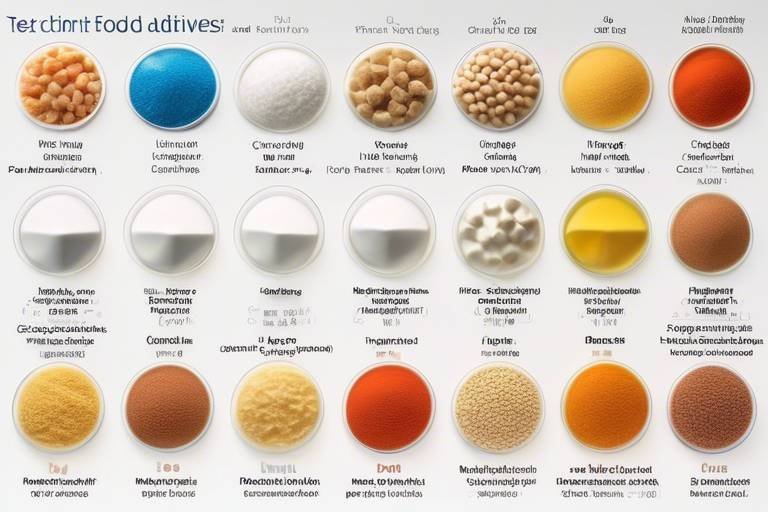The Physics of Home Appliances - Understanding Energy Use
Have you ever stopped to think about the hidden forces at play in your home appliances? From the moment you flick on a light switch to when you pop your dinner into the microwave, a fascinating world of physics is working behind the scenes. Understanding how these appliances operate not only satisfies our curiosity but also empowers us to make better choices about energy consumption. In this article, we will dive deep into the mechanics of energy use in home appliances, exploring the principles of energy consumption, the types of energy sources available, and how we can optimize our usage to save money and reduce our environmental footprint.
When it comes to home appliances, grasping the basics of energy consumption is essential. Think of energy as the fuel that powers our devices, while power is the rate at which that energy is used. Efficiency, on the other hand, refers to how well an appliance converts energy into useful work. To put it simply, if energy is the gas in your car, then power is how fast you can drive, and efficiency is how far you can go on a gallon. By understanding these concepts, you can make informed decisions that not only lower your utility bills but also contribute to a greener planet.
Home appliances can draw energy from various sources, each with its own set of pros and cons. The most common energy sources include:
- Electricity: The go-to source for most appliances, it’s versatile and convenient.
- Gas: Often used for heating and cooking, gas can be more efficient but comes with safety concerns.
- Renewable Options: Solar and wind energy are becoming more popular, but they require an initial investment and setup.
Each energy source impacts energy efficiency differently. For instance, while electric appliances are widely available, they may not always be the most energy-efficient option, especially in areas where electricity is generated from fossil fuels. On the flip side, gas appliances can be efficient but require proper ventilation and safety measures.
Electricity is the lifeblood of modern appliances, powering everything from your refrigerator to your washing machine. But how does this energy translate into functionality? Electrical appliances convert electrical energy into mechanical work or heat through various components like motors and heating elements. The efficiency of this conversion is crucial; if an appliance uses more energy than necessary, it can lead to higher energy bills and a larger carbon footprint.
Two key players in the world of electrical appliances are voltage and current. Voltage can be thought of as the pressure that pushes electric charges through a circuit, while current is the flow of those charges. Together, they determine how much power an appliance consumes. Understanding these properties can help you choose appliances that not only perform well but also consume energy efficiently.
Power ratings are like the MPG ratings for your car; they tell you how much energy an appliance uses. These ratings are typically displayed on the appliance itself, often in watts (W). A higher wattage doesn’t always mean better performance; it can also indicate higher energy consumption. When shopping for new appliances, pay close attention to these ratings to ensure you’re making energy-smart choices.
Gas-powered appliances offer a compelling alternative to their electric counterparts. They operate by burning natural gas to produce heat, which can be more efficient for certain tasks, like cooking. However, understanding their energy efficiency compared to electric models is crucial. For example, while gas stoves heat up quickly, they can also lead to higher emissions if not used responsibly. Balancing performance with environmental impact is key when considering gas appliances.
Energy efficiency ratings are like report cards for your appliances. They provide a snapshot of how well an appliance uses energy, helping consumers make informed choices. Various rating systems exist, but they all aim to highlight energy-efficient models that save money and reduce energy consumption. Knowing how to interpret these ratings can significantly impact your purchasing decisions.
You’ve probably seen the Energy Star label on appliances, but what does it really mean? Energy Star ratings indicate that a product meets strict energy efficiency guidelines set by the U.S. Environmental Protection Agency. Choosing Energy Star-certified products can lead to substantial savings on your energy bills while also benefiting the environment. It’s a win-win!
Not all appliances are created equal when it comes to energy efficiency. For instance, a high-efficiency washing machine can use significantly less water and energy than a standard model. By comparing different appliances, consumers can make informed decisions that align with their budget and sustainability goals. Remember, investing in energy-efficient appliances now can lead to savings in the long run.
Implementing strategies to reduce energy consumption can lead to significant savings. Here are some practical tips:
- Use appliances during off-peak hours when energy rates are lower.
- Unplug devices when not in use to prevent phantom energy drain.
- Regularly maintain your appliances to ensure they operate efficiently.
By adopting these simple habits, you can enhance your overall energy efficiency and lower your utility bills.
Smart appliances are revolutionizing the way we think about energy use. Equipped with technology that allows for remote control and monitoring, these devices can optimize energy consumption based on your habits. Imagine being able to adjust your thermostat from your smartphone or receive alerts when your washing machine finishes a cycle. Smart features not only offer convenience but also contribute to energy savings.
Sometimes, the simplest changes in consumer behavior can lead to the most significant reductions in energy consumption. Simple habits like turning off lights when leaving a room, using cold water for laundry, or running the dishwasher only when full can make a big difference. By being mindful of our energy use, we can all contribute to a more sustainable future.
Q: How can I tell if my appliance is energy efficient?
A: Look for the Energy Star label or check the power ratings. Appliances with lower energy consumption are generally more efficient.
Q: Are smart appliances worth the investment?
A: Yes! They can help you save money on energy bills and offer convenience through remote control features.
Q: What are some quick tips for reducing energy consumption?
A: Unplug devices when not in use, use energy-efficient settings, and consider using appliances during off-peak hours.

Energy Consumption Basics
Understanding the principles of energy consumption in appliances is crucial for optimizing usage and reducing costs. At the heart of this understanding are the concepts of energy, power, and efficiency. Energy, in its simplest form, is the capacity to do work. It can be found in various forms, such as electrical, thermal, or mechanical energy. When we use home appliances, we are essentially converting one form of energy into another to perform a specific task—be it washing clothes, cooling our food, or heating our homes.
Power, on the other hand, is the rate at which energy is consumed or produced. It’s measured in watts (W), which can sometimes be confusing for consumers. To put it simply, if energy is like the distance you travel, then power is like how fast you’re going. For instance, a 100-watt light bulb uses energy at a rate of 100 watts, meaning it consumes more energy than a 60-watt bulb in the same amount of time.
Now, let's talk about efficiency. Efficiency is about how well an appliance converts energy into the desired output. An efficient appliance will use less energy to perform the same task compared to a less efficient one. This is where the concept of energy efficiency ratings comes into play, guiding consumers to make smarter choices. The higher the efficiency rating, the more energy savings you can expect over time. For example, a refrigerator with an energy efficiency rating of A+++ will consume significantly less energy than a model rated D, even if both have the same capacity and features.
To give you a clearer picture, here’s a simple table that illustrates the relationship between energy, power, and efficiency:
| Concept | Definition | Unit of Measurement |
|---|---|---|
| Energy | The capacity to do work | Joules (J) or Kilowatt-hours (kWh) |
| Power | The rate of energy consumption | Watts (W) |
| Efficiency | The ratio of useful output to total input | Percentage (%) |
By grasping these fundamental concepts, you can start to appreciate how your home appliances operate and how their energy consumption affects your monthly bills. Have you ever noticed how some appliances seem to drain energy faster than others? This can often be attributed to their power ratings and efficiency levels. Understanding these aspects not only helps in choosing the right appliances but also encourages better habits in energy use.
In conclusion, the physics behind energy consumption in home appliances is not just a dry subject; it's a vital part of our daily lives. By understanding energy, power, and efficiency, we can make informed decisions that lead to savings and a more sustainable lifestyle. So, the next time you’re shopping for a new appliance, remember to look beyond the price tag and consider how its energy consumption will impact your home and your wallet.

Types of Energy Sources
When it comes to powering our beloved home appliances, we often take for granted the variety of energy sources available to us. Each source comes with its own set of advantages and disadvantages, and understanding these can significantly impact both our energy bills and our carbon footprints. In this section, we will dive into the primary energy sources utilized in home appliances, including electricity, gas, and renewable energy options. By the end of this discussion, you’ll have a clearer picture of which energy source might best suit your household needs.
Electricity is the reigning champion of energy sources in modern homes. It powers everything from refrigerators to washing machines, providing a reliable and consistent energy supply. One of the major benefits of using electricity is its versatility; it can be easily converted into different forms of energy, such as heat or light, depending on the appliance's requirements. However, the downside is that electricity can be costly, especially if your home relies on non-renewable sources like coal or natural gas for its generation.
On the other hand, we have gas-powered appliances. These devices, which include stoves and water heaters, utilize natural gas as their fuel source. A notable advantage of gas appliances is their efficiency; they often heat up faster than electric models, which can save time and energy. However, the downside is that gas appliances can contribute to greenhouse gas emissions, which is a growing concern in today’s climate-conscious world.
As we look toward the future, renewable energy sources are becoming increasingly popular. Solar panels, for example, harness sunlight to generate electricity, while wind turbines capture wind energy. These sources are not only sustainable but can also lead to significant long-term savings on energy bills. However, the initial installation costs can be high, and the efficiency of these systems can vary based on location and weather conditions.
To summarize, here’s a quick comparison of the three main energy sources:
| Energy Source | Advantages | Disadvantages |
|---|---|---|
| Electricity |
|
|
| Gas |
|
|
| Renewable Energy |
|
|
In conclusion, the choice of energy source for home appliances is not just a matter of convenience; it can have profound implications for your wallet and the environment. As technology advances, we have more options than ever to make informed choices about how we power our homes. Whether you lean towards the traditional reliability of electricity, the efficiency of gas, or the sustainability of renewable energy, understanding these energy sources will empower you to make decisions that align with your values and budget.

Electricity in Appliances
When we think about home appliances, the first thing that often comes to mind is electricity. It's the lifeblood of our modern conveniences, powering everything from your refrigerator to your washing machine. But have you ever wondered how these electrical appliances actually convert energy into the functionality we rely on daily? Understanding this process is key to grasping how we can optimize our energy consumption and reduce our utility bills.
At its core, electrical appliances operate by converting electrical energy into other forms of energy, such as mechanical, thermal, or light energy. For instance, your microwave transforms electrical energy into heat to cook food, while a blender converts it into mechanical energy to mix ingredients. The efficiency of this conversion is where the magic happens. The more efficiently an appliance can convert electricity into the desired output, the less energy it consumes overall.
One important aspect to consider is the power rating of appliances, often measured in watts. This rating indicates how much energy the appliance uses during operation. For example, a typical microwave might have a power rating of around 1,000 watts, while a refrigerator may range from 100 to 800 watts, depending on its size and efficiency. Understanding these ratings can help you make informed decisions when purchasing new appliances or when trying to reduce energy consumption in your home.
Moreover, the relationship between voltage and current plays a critical role in appliance performance. Voltage is the electrical potential that pushes the current through the appliance, while current is the flow of electric charge. The interplay between these two factors determines how efficiently an appliance operates. For example, if an appliance is designed to work at a specific voltage and is supplied with a lower voltage, it may draw more current to compensate, leading to inefficiencies and increased energy consumption.
To illustrate this, consider the following table that summarizes how voltage and current affect energy consumption:
| Voltage (V) | Current (A) | Power (W) |
|---|---|---|
| 120 | 10 | 1200 |
| 240 | 5 | 1200 |
This table shows how different combinations of voltage and current can lead to the same power output, emphasizing the importance of using appliances as intended to maximize efficiency. In essence, understanding these electrical properties can empower you to make smarter choices about your home appliances, ultimately leading to lower energy consumption and reduced costs.
In conclusion, electricity is not just a mere source of power; it's a complex system that, when understood, can lead to significant benefits in terms of energy efficiency. By knowing how appliances convert electrical energy and the factors that influence their performance, you can take steps to optimize your usage and contribute to a more sustainable future.
- What is the most energy-efficient appliance? The most energy-efficient appliances typically have high Energy Star ratings. Look for refrigerators, washing machines, and dishwashers that meet these standards.
- How can I reduce my electricity bill? Consider using energy-efficient appliances, unplugging devices when not in use, and utilizing smart technology to manage energy consumption.
- Do higher wattage appliances consume more energy? Generally, yes. However, the actual energy consumption also depends on how long the appliance is used. A lower wattage appliance used for a longer duration can sometimes consume more energy overall.

Voltage and Current
When it comes to understanding the performance of home appliances, two fundamental concepts stand out: voltage and current. These electrical properties are not just technical jargon; they play a crucial role in how efficiently your appliances operate and how much energy they consume. Think of voltage as the "pressure" that pushes electric charges through a circuit, while current is the "flow" of those charges. In simpler terms, voltage is like the water pressure in a hose, and current is the amount of water flowing through it. If you have high pressure but a narrow hose, the flow may be limited, just like high voltage with low current can affect appliance performance.
Understanding these concepts is essential for anyone looking to optimize their energy use and reduce costs. For instance, most household appliances are designed to operate at specific voltage levels, typically 120 volts or 240 volts, depending on the region and the appliance type. If an appliance is connected to a voltage that is too low, it may not function properly, leading to inefficiencies and potential damage. Conversely, if the voltage is too high, it can cause the appliance to overheat or even fail.
Current, measured in amperes (amps), indicates how much electricity is flowing through the appliance at any given moment. A higher current means more energy consumption, which translates into higher electricity bills. Therefore, it's important to choose appliances that are designed to operate efficiently within their specified voltage and current ranges. You might be wondering, "How can I find out the voltage and current requirements for my appliances?" Most appliances have a label or a manual that provides this information, making it easy for consumers to stay informed.
To illustrate the relationship between voltage, current, and power consumption, let’s take a look at the following table:
| Appliance | Voltage (V) | Current (A) | Power (W) |
|---|---|---|---|
| Microwave Oven | 120 | 10 | 1200 |
| Washing Machine | 240 | 15 | 3600 |
| Refrigerator | 120 | 6 | 720 |
This table shows how different appliances operate under various voltage and current conditions, allowing consumers to understand their energy consumption better. By recognizing how voltage and current interact, you can make more informed choices about which appliances to purchase and how to use them effectively.
In summary, grasping the concepts of voltage and current not only enhances your knowledge of how home appliances function but also empowers you to make smarter decisions that can lead to significant energy savings. So, the next time you’re shopping for an appliance, keep an eye on those voltage and current ratings—they could save you more than just a few bucks in the long run!
- What is the difference between voltage and current? Voltage is the potential difference that pushes electric charges through a circuit, while current is the flow of those charges.
- How do I know the voltage and current requirements of my appliances? Look for a label on the appliance or consult the user manual for specifications.
- Can using an appliance with the wrong voltage damage it? Yes, using an appliance with a voltage that is too high or too low can lead to inefficiencies or even permanent damage.

Power Ratings
When it comes to choosing home appliances, understanding is like having a secret weapon in your back pocket. These ratings indicate how much electrical power an appliance consumes, which directly affects your energy bills. But what exactly do these numbers mean, and why should you care? Let’s break it down!
Power ratings are usually measured in watts (W), and they tell you how much energy an appliance uses when it’s running. For example, a standard microwave might have a power rating of 1000 watts, while a refrigerator could be around 200 to 800 watts, depending on its size and features. The higher the wattage, the more energy it consumes, but this doesn’t always mean it’s less efficient. It’s essential to look at the efficiency of the appliance as well, which is often represented in the form of an Energy Efficiency Ratio (EER).
To put it into perspective, imagine you’re driving a car. Just because a car has a bigger engine (higher power rating) doesn’t mean it’s the most efficient vehicle on the road. Similarly, some appliances with lower wattage can perform just as well as their higher-rated counterparts when you consider how effectively they convert that power into useful work.
Another crucial aspect of power ratings is the concept of peak power versus average power. Peak power refers to the maximum amount of power an appliance might draw during its operation, while average power is what it typically uses over time. For instance, a washing machine may use a lot of power when the motor kicks in, but it might consume much less during the rinse cycle. Understanding these nuances can help you better estimate your energy costs.
Here’s a quick reference table to illustrate how different appliances compare in terms of power ratings:
| Appliance | Average Power Rating (Watts) |
|---|---|
| Microwave Oven | 800 - 1200 |
| Refrigerator | 100 - 800 |
| Washing Machine | 500 - 1500 |
| Dishwasher | 1200 - 1500 |
| Air Conditioner | 2000 - 5000 |
In conclusion, understanding power ratings is essential for making informed decisions when purchasing appliances. Not only does it help you gauge the potential energy costs, but it also allows you to compare the efficiency of different models. So, the next time you’re out shopping, don’t just look at the price tag—take a closer look at those power ratings and make your choice wisely!
- What is the difference between watts and kilowatts? Watts are a measure of power, while kilowatts are simply 1000 watts. Kilowatts are often used to express larger power ratings.
- Do higher power ratings always mean better performance? Not necessarily. Efficiency is just as important, so consider both power ratings and energy efficiency when choosing appliances.
- How can I find the power rating of an appliance? Power ratings are usually listed on the appliance's nameplate or in the user manual.

Gas-Powered Appliances
When we think about home appliances, we often picture the hum of electric motors and the flicker of LED lights. However, provide an intriguing alternative that many households rely on. These appliances, which include gas stoves, water heaters, and furnaces, utilize natural gas or propane as their energy source. But how do they compare to their electric counterparts in terms of efficiency and performance? Let’s dive into the mechanics and benefits of gas-powered appliances.
One of the primary advantages of gas-powered appliances is their efficiency. Generally speaking, gas appliances tend to heat up faster than electric ones. For instance, when you turn on a gas stove, the flame ignites immediately, providing instant heat for cooking. This is in stark contrast to electric stoves, which can take several minutes to reach the desired temperature. So, if you’re someone who values speed in the kitchen, gas appliances might just be your best friend.
Moreover, gas-powered appliances can be more cost-effective in the long run. While the initial purchase price might be similar to electric models, the ongoing costs can be lower due to the generally cheaper price of natural gas compared to electricity in many regions. This can lead to significant savings on your monthly energy bill. However, it's essential to consider the availability of natural gas in your area, as well as the costs associated with installation and maintenance.
Another fascinating aspect of gas appliances is their environmental impact. While burning natural gas does produce carbon emissions, it is often viewed as a cleaner alternative to other fossil fuels, such as coal. Additionally, advancements in technology have led to the development of more efficient gas appliances that minimize emissions. For example, modern gas furnaces often come equipped with features that optimize combustion, resulting in lower emissions and higher efficiency.
However, it’s important to note that gas appliances require proper ventilation to ensure safety and efficiency. Poor ventilation can lead to the buildup of harmful gases, such as carbon monoxide, which can pose serious health risks. Therefore, regular maintenance and inspections are crucial to ensure that your gas appliances are functioning safely and efficiently.
In summary, gas-powered appliances offer a range of benefits, including speed, cost-effectiveness, and reduced environmental impact. Yet, they are not without their challenges, particularly concerning safety and ventilation. As you consider upgrading or purchasing new appliances, weighing these factors will help you make an informed decision that aligns with your lifestyle and values.
- Are gas-powered appliances more efficient than electric ones? Generally, yes. Gas appliances heat up faster and can be more cost-effective in the long run.
- What types of gas appliances are available? Common gas appliances include stoves, water heaters, furnaces, and dryers.
- Do gas appliances require special ventilation? Yes, proper ventilation is essential to ensure safety and efficiency when using gas appliances.
- How can I maintain my gas appliances? Regular inspections, cleaning, and professional maintenance can help keep your gas appliances in top shape.

Energy Efficiency Ratings
When it comes to purchasing home appliances, understanding is crucial. These ratings provide a clear indication of how much energy an appliance consumes compared to its peers, allowing consumers to make informed decisions that can lead to significant savings on energy bills. In a world where energy costs are continually rising, being savvy about energy consumption can not only benefit your wallet but also the environment.
Energy efficiency ratings are often displayed on labels that accompany appliances. These labels typically include a scale that ranges from highly efficient to inefficient, helping consumers quickly assess which products are worth their investment. The most recognized rating system in the United States is the Energy Star label, which signifies that a product meets specific energy efficiency criteria set by the Environmental Protection Agency (EPA). But what does this really mean for you as a consumer?
To better understand energy efficiency ratings, let’s break down some of the most common rating systems:
| Rating System | Description | Benefits |
|---|---|---|
| Energy Star | Indicates appliances that are at least 20% more efficient than standard models. | Lower energy bills and reduced environmental impact. |
| EU Energy Label | A scale from A+++ (most efficient) to D (least efficient) used in Europe. | Easy comparison across appliances and clear efficiency guidelines. |
| LEED Certification | A rating for buildings that emphasizes sustainability and energy efficiency. | Promotes eco-friendly practices and reduces overall energy consumption. |
Each rating system has its own criteria and advantages, which can sometimes lead to confusion. However, the key takeaway is that appliances with higher energy efficiency ratings generally require less energy to operate, which translates into lower utility costs. For instance, an Energy Star-rated refrigerator might use 15% less energy than a standard model, making it a smart choice for both your home and the planet.
Moreover, energy efficiency ratings also play a significant role in consumer decision-making. Many consumers are now more aware of their carbon footprints and are actively seeking out appliances that can help reduce their energy consumption. This trend has led manufacturers to innovate and produce more energy-efficient models, contributing to a healthier environment.
In conclusion, being familiar with energy efficiency ratings empowers you to make better purchasing decisions. Whether you're in the market for a new washing machine, refrigerator, or air conditioner, always check the energy label. Not only will you save money in the long run, but you'll also be doing your part in conserving energy and protecting our planet.
- What is the Energy Star label? - It indicates that an appliance meets specific energy efficiency standards set by the EPA.
- How can I find the energy efficiency rating of an appliance? - Look for the energy label on the appliance or its packaging.
- Do energy-efficient appliances really save money? - Yes, they typically consume less energy, leading to lower utility bills over time.

Understanding Energy Star Ratings
The Energy Star program is a widely recognized label that indicates energy efficiency in various appliances. Established by the U.S. Environmental Protection Agency (EPA), this initiative aims to help consumers make informed choices that not only save them money but also reduce their environmental impact. When you see the Energy Star label on a product, it means that the appliance meets strict energy efficiency guidelines set by the EPA. But what does that really mean for you as a consumer?
First off, Energy Star-rated appliances typically use 10-50% less energy than their non-certified counterparts. This can lead to significant savings on your utility bills over time. For instance, if you purchase an Energy Star-rated refrigerator, you might save anywhere from $50 to $100 annually on energy costs compared to a standard model. That’s not just a small change; it’s a big deal when you think about how many appliances we use in our homes!
Moreover, Energy Star ratings extend beyond just appliances. They also apply to homes, office buildings, and even electronics. This means that when you invest in Energy Star-certified products, you’re contributing to a larger movement aimed at promoting sustainability and reducing greenhouse gas emissions. It’s like being part of a community that cares about the planet while also keeping your wallet happy!
Now, let’s break down how these ratings are determined. The EPA considers various factors, including:
- Energy Use: The amount of energy consumed during operation.
- Performance: How well the appliance performs its intended function.
- Design: Innovative features that enhance efficiency.
To qualify for the Energy Star label, a product must outperform standard models in its category. For example, an Energy Star washing machine not only uses less water and energy but also cleans your clothes just as effectively, if not better, than a traditional model. It’s a win-win situation!
Furthermore, the Energy Star program continually updates its criteria to reflect advancements in technology and changes in consumer behavior. This means that products are not just rated once and left in the dust; they are regularly evaluated to ensure they meet current standards. As a result, when you choose Energy Star-rated products, you can rest assured you’re getting the best of the best in energy efficiency.
In conclusion, understanding Energy Star ratings is crucial for making informed purchasing decisions. By opting for Energy Star-certified appliances, you’re not only investing in your home but also in a sustainable future. So next time you’re in the market for a new appliance, remember to look for that little blue label. It’s more than just a sticker; it’s a promise of quality, efficiency, and environmental responsibility!
- What types of products have Energy Star ratings?
Energy Star ratings apply to a wide range of products, including refrigerators, washing machines, dishwashers, air conditioners, and even whole homes! - How can I find Energy Star products?
You can find Energy Star products by visiting the official Energy Star website or looking for the label on products in stores. - Are Energy Star products more expensive?
While some Energy Star products may have a higher upfront cost, the long-term savings on energy bills can often offset this initial investment.

Comparing Efficiency Across Appliances
When it comes to home appliances, not all are created equal, especially regarding energy efficiency. It's like comparing apples to oranges; some appliances pack a punch with their energy-saving features, while others can leave your wallet feeling a little lighter. Understanding the nuances of energy consumption across various devices can empower you to make smarter choices that benefit both the environment and your bank account.
For instance, let’s take a look at refrigerators and dishwashers. Modern refrigerators are designed with advanced insulation and energy-efficient compressors that significantly reduce electricity consumption. On the other hand, older models can consume up to 50% more energy. The difference can be staggering! In fact, a typical Energy Star refrigerator uses about 30% less energy than non-certified models. This means that the initial investment in a new fridge can pay off in lower energy bills over time.
Similarly, dishwashers have come a long way in terms of efficiency. A standard dishwasher uses about 3.5 gallons of water per load, compared to washing dishes by hand, which can use up to 27 gallons for the same number of dishes. This not only saves water but also reduces energy consumption, as heating that water can be a significant part of the energy cost. So, if you’re still washing dishes by hand, it might be time to reconsider!
To give you a clearer picture, let’s compare the energy consumption of a few common appliances in a table format:
| Appliance | Energy Consumption (kWh/year) | Water Consumption (gallons/year) |
|---|---|---|
| Refrigerator (Energy Star) | 400 | N/A |
| Dishwasher (Energy Star) | 270 | 600 |
| Washing Machine (Energy Star) | 300 | 3,000 |
| Conventional Oven | 500 | N/A |
This table illustrates just how much energy different appliances can consume. The numbers speak volumes, don’t they? By choosing Energy Star-rated appliances, you can drastically cut down on your energy and water usage, making a positive impact on both your utility bills and the environment.
Ultimately, comparing efficiency across appliances isn’t just about looking at one single factor; it's about understanding the complete picture. For example, while a high-efficiency washing machine may cost more upfront, the savings in water and energy bills can make it a worthwhile investment. It’s like planting a tree; it takes time to grow, but once it does, the shade and fruit are invaluable.
As consumers, we have the power to influence manufacturers by choosing energy-efficient models. When we opt for appliances that are designed with efficiency in mind, we send a clear message that sustainability matters. And remember, every little bit counts—whether it's switching to an Energy Star appliance or simply being mindful of how we use the devices we already have.
- What is the best way to determine an appliance's energy efficiency? Look for the Energy Star label, which indicates that the appliance meets strict energy efficiency guidelines set by the EPA.
- Are energy-efficient appliances more expensive? They often have a higher upfront cost, but the long-term savings on energy bills can offset this initial investment.
- How can I improve the energy efficiency of my current appliances? Regular maintenance, such as cleaning filters and ensuring proper insulation, can enhance efficiency.

Reducing Energy Consumption
Reducing energy consumption is not just a matter of saving a few bucks on your utility bill; it’s about making a significant impact on the environment and ensuring that our resources last for generations to come. In our fast-paced world, where we rely heavily on home appliances, it’s crucial to adopt strategies that not only enhance our lifestyle but also promote sustainability. So, how can we achieve this balance? Let’s dive into some practical tips that can make a world of difference!
First and foremost, understanding your appliances is key. Many people underestimate how much energy their appliances consume. For instance, did you know that older refrigerators can use up to 50% more energy than newer, more efficient models? This is where energy efficiency ratings come into play. By choosing appliances with high energy ratings, you can significantly lower your energy consumption. Look for the Energy Star label, which indicates that the appliance meets strict energy efficiency guidelines set by the U.S. Environmental Protection Agency.
Another effective strategy is to utilize smart appliances. These modern devices are designed to optimize energy usage through advanced technology. For example, smart thermostats can learn your heating and cooling preferences and adjust themselves accordingly, ensuring that energy isn’t wasted when you’re not home. Similarly, smart washing machines can determine the optimal water and energy levels needed for each load, further minimizing waste. Imagine controlling your appliances from your smartphone, ensuring they run only when needed—how cool is that?
Moreover, behavioral changes play a significant role in reducing energy consumption. Simple habits can lead to substantial savings over time. For instance, consider the following practices:
- Unplugging devices when they’re not in use to prevent phantom energy consumption.
- Using cold water for laundry whenever possible, as heating water accounts for a large portion of energy use.
- Regularly cleaning and maintaining appliances to ensure they operate efficiently.
Additionally, being mindful of your energy usage during peak hours can lead to better energy management. Many utility companies offer lower rates during off-peak hours, so running your dishwasher or washing machine late at night can save you money while reducing strain on the energy grid. It’s like getting a two-for-one deal!
Finally, consider investing in renewable energy sources. If possible, installing solar panels can drastically reduce your reliance on traditional energy sources. Not only will you be contributing to a cleaner environment, but you’ll also enjoy long-term savings on your energy bills. Think of it as planting a tree today that will provide shade for your home tomorrow!
In conclusion, reducing energy consumption is a multifaceted approach that involves understanding your appliances, leveraging technology, making behavioral changes, and embracing renewable energy. By implementing these strategies, you’ll not only save money but also contribute to a more sustainable future. So, are you ready to make a change?
Q: What is the easiest way to reduce energy consumption at home?
A: One of the simplest ways is to switch to energy-efficient appliances and adopt mindful habits, like unplugging devices when not in use.
Q: Do smart appliances really save energy?
A: Yes! Smart appliances are designed to optimize energy use, often adjusting their operation based on your habits and preferences.
Q: How can I tell if an appliance is energy-efficient?
A: Look for the Energy Star label, which indicates that the appliance meets specific energy efficiency criteria.
Q: Is it worth investing in solar panels?
A: While the initial investment can be high, solar panels can lead to significant savings on energy bills over time and reduce your carbon footprint.

Smart Appliances
In today's fast-paced world, have become a game-changer in how we manage our homes and energy consumption. These devices, equipped with cutting-edge technology, not only make our lives easier but also help us save on energy costs. Imagine a refrigerator that can remind you when you're running low on groceries or a washing machine that you can control from your smartphone while you're out and about. Isn't that incredible?
At the core of smart appliances is the concept of connectivity. Many of these devices are linked to the internet, allowing them to communicate with other smart devices within your home. This interconnectivity enables features such as remote monitoring and control. For instance, you can adjust your thermostat from your office, ensuring your home is at the perfect temperature when you arrive. The convenience is undeniable, but the energy savings can be substantial as well.
One of the most significant advantages of smart appliances is their ability to optimize energy use. They often come with built-in sensors that can detect usage patterns and adjust their operation accordingly. For example, a smart dishwasher might run during off-peak hours when electricity rates are lower, or a smart thermostat can learn your schedule and adjust heating or cooling to minimize energy waste. This not only leads to lower utility bills but also reduces the overall demand on the energy grid.
However, it's essential to consider the initial investment in smart appliances. While they can save you money in the long run, the upfront costs can be higher than traditional models. But think of it as an investment in your future—one that pays off through lower energy bills and enhanced convenience. Moreover, many utility companies offer rebates for energy-efficient appliances, which can help offset those initial costs.
To illustrate the impact of smart appliances on energy efficiency, let's take a look at a comparison table of energy consumption between traditional and smart appliances:
| Appliance Type | Traditional Energy Use (kWh/year) | Smart Energy Use (kWh/year) | Estimated Savings (%) |
|---|---|---|---|
| Refrigerator | 600 | 450 | 25% |
| Washing Machine | 500 | 350 | 30% |
| Dishwasher | 300 | 225 | 25% |
As shown in the table, smart appliances can significantly reduce energy consumption compared to their traditional counterparts. This reduction not only benefits your wallet but also contributes to a more sustainable environment by lowering carbon emissions associated with energy production.
In conclusion, investing in smart appliances is not just about convenience; it's about making a conscious choice to enhance energy efficiency in your home. As technology continues to advance, these devices will become even more integrated into our daily lives, helping us to manage our energy consumption effectively. So, why not embrace the future and make your home smarter?
- What are smart appliances? Smart appliances are devices that connect to the internet and can be controlled remotely, often featuring energy-saving capabilities.
- Do smart appliances really save energy? Yes, many smart appliances are designed to optimize energy use, leading to lower utility bills.
- Are smart appliances worth the investment? While the initial cost may be higher, the long-term savings and convenience often make them a worthwhile investment.
- Can I control smart appliances with my smartphone? Most smart appliances come with apps that allow you to monitor and control them from your smartphone.

Behavioral Changes
When it comes to reducing energy consumption in our homes, sometimes the most significant changes can come from simple shifts in our daily behaviors. You might be surprised to learn how little adjustments can lead to substantial savings on your energy bills! Think of it like tuning a musical instrument; a few minor tweaks can create a harmonious sound, or in this case, a more energy-efficient home.
One of the easiest changes to implement is to be mindful of appliance usage. For instance, did you know that running your dishwasher or washing machine during off-peak hours can save you money? Many utility companies offer lower rates during specific times, so scheduling your laundry or dishwashing accordingly can make a noticeable difference. Additionally, consider the temperature settings on your appliances. Lowering the thermostat on your water heater just a few degrees can lead to significant energy savings without sacrificing comfort.
Another effective strategy is to embrace energy-efficient habits. For example, instead of preheating your oven for every dish, try using the oven's residual heat to finish cooking. This is akin to letting a car coast downhill rather than accelerating the whole way; it’s all about using what you already have to your advantage. Furthermore, turning off lights when you leave a room or unplugging devices that aren’t in use can dramatically cut down on wasted energy. It’s about creating a culture of conservation in your home.
Moreover, investing in smart technology can also lead to behavioral changes that promote energy efficiency. Smart thermostats, for instance, learn your habits and adjust settings automatically. Imagine having a personal assistant who knows when you’re home or away and optimizes your energy use accordingly! This not only enhances convenience but also helps you save money without even thinking about it.
Lastly, it’s essential to educate your family members about energy conservation. When everyone is on the same page, it becomes easier to implement changes. You might even consider turning it into a fun challenge! For instance, you could track who can reduce their energy consumption the most in a month. This not only fosters awareness but also encourages teamwork in making your home more energy-efficient.
In summary, small behavioral changes can lead to significant reductions in energy consumption. By being mindful of how and when we use our appliances, embracing energy-efficient habits, leveraging smart technology, and educating our families, we can create a more sustainable and cost-effective home environment. So, why not start today? After all, every little bit counts!
- What are some simple ways to reduce energy consumption at home?
Simple ways include turning off lights when not in use, unplugging devices, using energy-efficient appliances, and adjusting thermostat settings.
- How can smart appliances help save energy?
Smart appliances can optimize energy use by learning your habits and adjusting settings automatically, ensuring energy is used only when necessary.
- Is it worth investing in energy-efficient appliances?
Yes, while they may have a higher upfront cost, energy-efficient appliances can save you money in the long run through reduced energy bills.
- Can behavioral changes really make a difference?
Absolutely! Small changes, like using appliances during off-peak hours or turning off unused lights, can lead to significant energy savings over time.
Frequently Asked Questions
- What is energy consumption in home appliances?
Energy consumption refers to the amount of energy used by appliances to perform their functions. It's crucial to understand this concept to manage energy costs effectively and choose appliances that offer better efficiency.
- How do I know which energy source is best for my appliances?
Choosing the right energy source depends on various factors, including availability, cost, and efficiency. Electric appliances are common, but gas-powered options can be more efficient in some cases. Consider your specific needs and local energy prices when deciding.
- What are power ratings, and why are they important?
Power ratings indicate the amount of energy an appliance uses, usually measured in watts. Understanding power ratings helps consumers select energy-efficient appliances that can save money on electricity bills over time.
- How do Energy Star ratings work?
Energy Star ratings are given to appliances that meet strict energy efficiency guidelines set by the U.S. Environmental Protection Agency. Choosing Energy Star-certified products can lead to significant energy savings and lower utility bills.
- What are some practical tips for reducing energy consumption?
To reduce energy consumption, consider using smart appliances that optimize energy use, unplugging devices when not in use, and adopting energy-saving habits like washing clothes in cold water and running dishwashers only when full.
- Can smart appliances really save energy?
Yes! Smart appliances often come with features that allow for better energy management, such as scheduling usage during off-peak hours or adjusting settings based on your habits, leading to significant energy savings over time.
- What behavioral changes can help in maximizing appliance efficiency?
Simple changes like turning off appliances when not in use, maintaining appliances regularly, and using them at optimal times can greatly enhance energy efficiency and lower your energy bills.



















